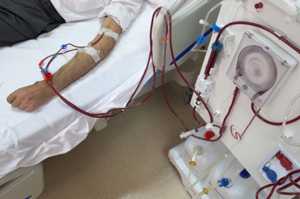Key Findings: High 1 Year Mortality in Adults with Sickle Cell Disease and End-Stage Renal Disease (ESRD)

Recently, researchers used data from the Centers for Medicare and Medicaid Services (CMS) to examine the link between death and pre-ESRD care in people with ESRD who started hemodialysis during the period June 1, 2005 – May 31, 2009. The results were published in British Journal of Haematology. You can read the abstract here. The key findings from this article are summarized in the following text.
Sickle Cell Disease (SCD) is an inherited red blood cell disorder that affects 90,000 – 100,000 Americans of all races. Healthy red blood cells are round, and they move through small blood vessels to carry oxygen to all parts of the body. In someone who has SCD, the red blood cells become hard and sticky and look like a C-shaped farm tool called a “sickle.” The sickle cells die early, which causes a constant shortage of red blood cells. When sickle cells travel through small blood vessels, they can get stuck and prevent blood flow and oxygen from reaching vital organs. This causes pain that can start suddenly, be mild to severe, and can last for any length of time. Nearly a third of people with SCD will develop chronic kidney disease and some of these will develop end-stage renal disease (ESRD).
ESRD is the complete or almost complete failure of the kidneys to work. The kidneys remove waste and excess water from the body. ESRD almost always comes after chronic kidney disease. Chronic kidney disease causes the kidneys to slowly stop working over 10-20 years before ESRD is reached. Once ESRD is reached, people must have a kidney transplant or some form of renal replacement therapy (RRT) to survive. One form of RRT is hemodialysis which involves cleansing of the blood using a special machine two to three times per week.
The purpose of this study was to determine whether pre-ESRD care decreased mortality from ESRD among people with ESRD due to SCD. For the study, pre-ESRD care was defined as receipt of care from a doctor specializing in chronic kidney disease for at least 6 months before beginning RRT with hemodialysis. This care involves the application of evidence-based guidelines for the early detection and management of chronic kidney disease.
Main findings from this study:
- The one year death rate following an ESRD diagnosis was almost three times higher in people with ESRD due to SCD when compared to those with ESRD from other causes.
- Among patients with ESRD due to SCD, those receiving pre-ESRD care were about 30% less likely to die than those who did not receive pre-ESRD care.
- Pre-ESRD care for people with SCD and chronic kidney disease appears to reduce the rate of death following the start of hemodialysis.
- Current clinical practice guidelines for chronic kidney disease and ESRD should be reviewed and revised to include specific recommendations for people with SCD.
- Early referral to a nephrologist may decrease the risk of death for people with SCD and chronic kidney disease.
CDC Activities
The Centers for Disease Control and Prevention (CDC), National Center on Birth Defects and Developmental Disabilities, Division of Blood Disorders considers SCD a major public health concern and is committed to conducting surveillance, promoting health through education and awareness, and forming strategic collaborations to address unmet health needs.
- Surveillance: In 2010, the Registry and Surveillance System for Hemoglobinopathies (RuSH) pilot project was implemented to collect state-specific, population-based data on people with SCD and thalassemia. The pilot is being conducted in collaboration with the National Institutes of Health’s National Heart, Lung, and Blood Institute. Seven states were funded to participate in data collection: California, Florida, Georgia, Michigan, New York, North Carolina, and Pennsylvania. The pilot project was designed to assess the possibility of developing a national surveillance system to collect information about people with SCD and thalassemia. The information collected will assist in determining how many people are affected by these conditions.
- Health Promotion and Education: CDC strives to educate people about SCD by providing free materials to families affected by the disease. These materials discuss how to live well with SCD, how to prevent infections, and when to see a doctor. In addition, CDC is working to raise awareness of SCD among the general public. This effort will be particularly helpful to groups such as teachers and other nonmedical professionals who care for or work with people with SCD.
- Collaboration: CDC also has begun an agency-wide SCD multidisciplinary working group to explore opportunities to address unmet needs in research, surveillance, and health education. The working group will unite the efforts and energies of all groups within CDC that are working on this disease.
More Information
To learn more about SCD, please visit https://www.cdc.gov/ncbddd/sicklecell/index.html. For more information about blood disorders, please visit https://www.cdc.gov/ncbddd/blooddisorders/index.html.
Reference
Agency for Healthcare Research and Quality. Healthcare Cost and Utilization Project. Statistical Brief #21: Sickle Cell Disease Patients in U.S. Hospitals, 2004. http://www.hcup-us.ahrq.gov/reports/statbriefs/sb21.pdf. Accessed December 2, 2009.
Reference for Key Findings Feature:
McClellan, A. C., Luthi, J.-C., Lynch, J. R., Soucie, J. M., Kulkarni, R., Guasch, A., Huff, E. D., Gilbertson, D., McClellan, W. M. and DeBaun, M. R. (2012), High one year mortality in adults with sickle cell disease and end-stage renal disease. British Journal of Haematology. doi: 10.1111/bjh.12024.
- Page last reviewed: August 9, 2017
- Page last updated: November 29, 2012
- Content source:


 ShareCompartir
ShareCompartir